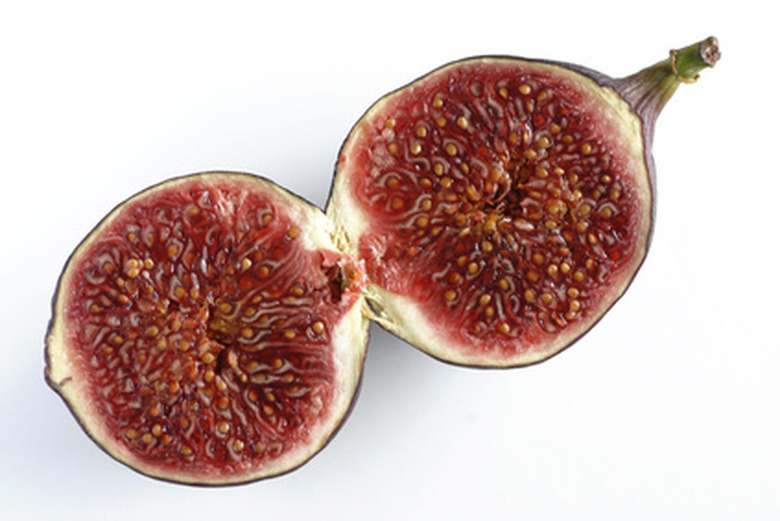The Best Fig Trees For Central Texas
Fig trees, known botanically as Ficus carica are a fruit tree common to most regions in the state of Texas. Many cultivars of common fig are grown successfully in central Texas. Nearly all will thrive when planted in semi-protected sites or near structures, often referred to as dooryard plantings, versus open orchards. In central Texas, fig trees will require regular irrigation, full sun exposure and temperatures consistently above 10 degrees F.
Celeste
Celeste is the fig that can tolerate the coldest temperatures and is ideal for fresh raw, dried and preserved eating. It is brown to purple black in hue and the fruit are ripe for harvest in the early summer ahead of other single season fig cultivars. It is resistant to invasion of the dried fruit beetle through the stem eye, which lessens crop loss and overall infestation.
- Fig trees, known botanically as Ficus carica are a fruit tree common to most regions in the state of Texas.
- It is brown to purple black in hue and the fruit are ripe for harvest in the early summer ahead of other single season fig cultivars.
Brown Turkey
Texas Everbearing fig, most commonly known as Brown Turkey, is a cultivar of common fig that is most popular fig grown in Central Texas. The tree produces three flushes of fruit beginning in May, again in late June and then in August. The figs are almost without seeds, roughly 2 inches in size and considered to have a mild, sweet fig taste.
Magnolia
Magnolia fig cultivars, including the varieties Madonna, Dalmatia and Brunswick, is a desired cultivar for commercially preserved figs. It can split and spoil in very wet weather which is not as much of a problem in the central portion of the state. Magnolia cultivars can recover well from occasional freezing temperatures. The fruit are mid-size to large and the skin is brown in hue and the interior flesh a golden hue. It will fruit readily on old and new wood, making it a prolific producer.
- Texas Everbearing fig, most commonly known as Brown Turkey, is a cultivar of common fig that is most popular fig grown in Central Texas.
- The figs are almost without seeds, roughly 2 inches in size and considered to have a mild, sweet fig taste.
Plant Fig Trees In Texas
When selecting a fig for the home garden, almost all gardeners in Texas plant the common fig (Ficus carica). Figs are deciduous and typically grow in U.S. Department of Agriculture plant hardiness zones 7a through 10b, but there are differences among cultivars. Gardeners living in drier regions of the state need to give the tree supplemental irrigation for proper growth and production of fruit. If you live in a part of Texas without winter freezes, plant fig trees at the beginning of their autumn dormancy when their leaves begin to lose their color. Choose a location that gets sun most or all the time. Sitting in water will stunt fig trees and eventually kill them. Use sterile pruning shears to remove dried or broken roots. Prune the top one-third of the trunks of dormant bare root or container trees to make up for the roots they lost when they were dug by the nursery. Dig a hole wider and deeper than the width and depth of the roots. Keep the soil uniformly moist. A young fig tree will use carbohydrates in its roots and young trunk to fuel its initial growth. ** Do not fertilize at planting. ** **'Celeste'** (Ficus carica 'Celeste,' USDA zones 6a through 9b), is the most cold hardy of fig trees grown in Texas. A large, vigorous, productive tree, 'Celeste' typically yields rich, sweet figs in mid to late June. The figs can crack or sour in very wet years. ' Texas Everbearing' is especially adapted to east and central Texas. *
- When selecting a fig for the home garden, almost all gardeners in Texas plant the common fig (Ficus carica).
- If you live in a part of Texas without winter freezes, plant fig trees at the beginning of their autumn dormancy when their leaves begin to lose their color.
References
- Texas A&M University: Figs
- Texas A&M University Extension: Home Fruit Production – Figs
- Texas A&M University Extension: Figs and Citrus for Texas Gardens
- Texas A&M University Extension: Figs
- National Gardening Association: Figs
- University of Florida IFAS Extension: Disinfecting Pruning Tools
- USDA: Plant Hardiness Zone Map
- Plantlust: Ficus Carica 'Alma'
- Plantlust: Ficus Carica 'Brown Turkey'
- Plantlust: Fiscus Carica 'Celeste'
- Plantlust: Ficus Carica 'LSU Purple'
- Plantlust: Ficus Carica
